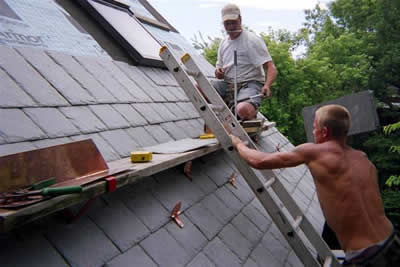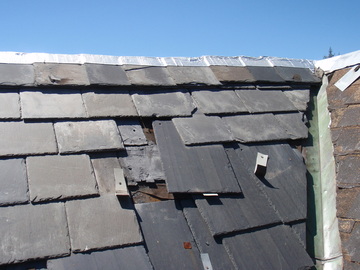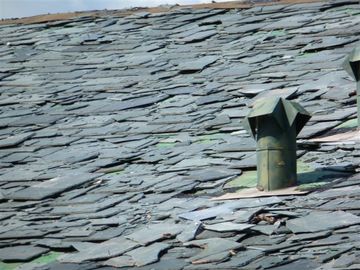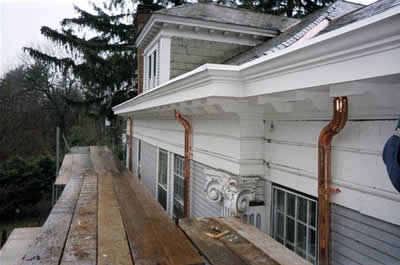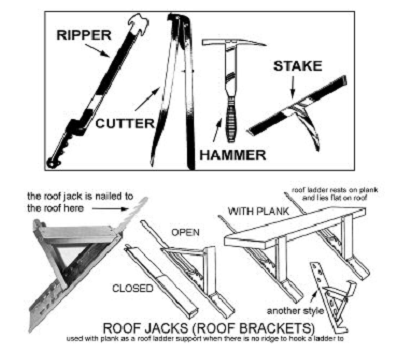Slate Roofing 101
|
Slate Roofs: A Primer on their Repair and Restoration
Slate has been used as a roofing material for centuries in Europe and has been the preferred choice for homes and buildings in the United States since the nineteenth century. Slate roofs are still seen frequently in upstate New York and throughout New England. The slate quarries of Granville, New York, Vermont and the Monson region of Maine were in full operation after the Civil War. This coincided with several significant periods of building growth in the nation between 1870 and the 1920’s. Many of the original slate roofs from this period survive today on homes, churches, libraries, schools, and other institutional buildings. What does not exist, however, is a ready-supply of competent, capable contractors to repair and restore slate roofs. With a basic understanding of this highly-specialized roofing system, home owners can generally assess the current condition of their slate roof, its life expectancy and, if necessary, the potential for restoration. The information that follows will help in assessing and identifying your roof’s needs as you, armed with this information, carefully screen potential roofing contractors to effect these repairs. Olde Mohawk Historic Preservation is the preferred contractor for such work in Boston and throughout New England. What goes wrong with slate roofs? In most instances, the problem is one of the following: • Variations in duration and quality • Flashings and other metalwork need replacement • Earlier repairs by irresponsible roofing contractors Variations in duration and quality of slate Slate is pulled from the earth in massive slabs and dressed down into individual shingles mostly by hand. Slate is stone, and stone is long lasting. However, stone is a natural material and may have minute or even invisible fissures that will ultimately cause slates to break and slide off the roof. Roofing slates are rated by ANSI according to hardness. Softer slates (rated S2 or S3) may become crumbly and will delaminate, sometimes, as early as 55 years, and certainly by 80-100 years. These softer slate roofs (commonly from Pennsylvania) cannot be saved or restored, for the most part, but repairs can buy time. Good, hard slate, like most New York, Vermont, Peach Bottom, Buckingham, or Monson, will last for hundreds of years on a properly cared for roof. It is critical that people who own, inspect or work on slate roofs are able to identify the slate on the roof in question. This single-most important information will provide details as to its type, origin, longevity, characteristics, and qualities. Contact Olde Mohawk for a free consultation specific to your slate roof. Roofing slate is still being quarried and sold in New York and Vermont (as well as Pennsylvania and Virginia.) Slate was also once quarried in Georgia and Maine (home of the world-famous Monson slate.) Flashing replacement and built-in gutters While the slate may last “forever,” the metal flashings will not. Flashings are essentially the metalwork used to prevent the penetration of water wherever there is an abrupt angle or opening in the roof (ie, chimneys, valleys, dormers.) Often, flashings were made from terne-coated steel, which is a steel coated with a lead/tin combination. This is sometimes, incorrectly, called “tin.” Terne-coated steel has to be painted regularly or corrosion will occur. Copper flashings (either plain copper or lead-coated) were most commonly installed on government buildings, churches, and similar institutions and upscale homes. Copper will oxidize as vert de gris appears. Copper will begin to fail after about 60 to 70 years in areas of high wear, such as valleys. The copper industry suggests a life of 80 years. Older copper flashings can be painted in order to extend their lives. Too often, the flashings fail and unscrupulous roofing contractors convince homeowners to replace their good, slate roof with asphalt. Only the flashings should be replaced, not the entire roof. These types of projects are routine for slate roof restoration contractors. The adjoining slates are removed to allow for replacement of the flashings. The removed slate are then installed in their original locations, laving the roof, in appearance, as it was before, except for the flashing. The standard upon which a repair is judged is that it must not appear to the layperson that any repair, at all, took place, except for new, visible flashings. Box gutter linings, or “built-in” gutters, are another common problem on old slate roofs because the metal deteriorates and leaks. Just like valleys and other flashings, they can be replaced without removing and replacing the entire roof. If left unchecked, the entire gutter boxes will rot and need to be rebuilt and replaced. Beware of irresponsible roofing contractors The cause of many leaking slate roofs is not natural wear, metal failures, or even cracked slates. It is, quite simply, bad work. Many unqualified people claim to have the ability to repair slate roofs. Fully half of the work done annually by a typical slate roofing contractor involves the removal and replacement of faulty repair work. Home owners with slate roofs often pay exorbitant sums to have their roofs trashed by these fly-by-nighters, then they have to pay even more of their hard-earned money to have them fixed and repaired correctly. The types abuses committed against slate roofs include the ones that are face-nailed, tarred, repaired with non-matching slates, coated, or reflashed incorrectly (see photos). One should NEVER tar or coat the surfaces of slate roofs. Such actions are aesthetically displeasing, often irreversible, and ineffective. Roofing contractors are notorious for advising homeowners to replace a perfectly good roof. Home owners will often listen to such advice when a lack of competent slaters makes it the only advice available. These issues, combined, have been the downfall of countless slate roofs, lost forever to ignorance, neglect, and despair. Contact Olde Mohawk for a free assessment and discussion of your roof’s needs. As you seek estimates and advice from other roofers, use the information in this document to test their knowledge and screen their methods. Watch their eyes widen as they realize YOU know more about slate roofing than they do! Replacing broken and missing slate It is not uncommon for a century-old slate roof to have 50 or more slates simply fail from a variety of causes. Slate contains natural faults or hairline cracks and may eventually break. A 20 square roof (2,000 square feet), with a typical 10"x 20" slate, will have about 3,400 slates. If 50 of them fail after a hundred years, then the failure rate of the roof is 1.5 percent over 100 years— or a 98.5 percent success rate over a century. That’s an A+. However, just one missing slate is all a leak needs to get started. For a professional slater, the solution is not rocket science. Replacement slates must never be fastened in place with visible straps or exposed nails (known as “face-nails”). I repeat, if a roofer describes face-nailing to you as his preferred method, tell him to leave your property IMMEDIATELY. NEVER let him on your roof and ask him to forget your address. Ask that he not even look at the slate if he ever happens to drive past your house in the future! There are two acceptable techniques for fastening replacement slates: the “nail and bib” method or the “slate hook”. The nail and bib method is the most widely used. The broken slate is removed with a slate ripper and the replacement slate is anchored with a nail in the slot between the two, overlying slates. A small square of flashing is slid under the two, overlying slates on the next course, above, and over the new nail head. The bib is bent a little so friction keeps it in place. Bibs can be aluminum, copper, or other non-corrodible metal, but shiny and reflective metals that are visible from the ground should never be used. Copper or brown-painted aluminum (coilstock) blends nicely into the roof. A slate hook is a hard wire hook made of galvanized steel, copper or stainless steel, approximately three inches long. A small exposed loop hooks the replacement slate in place. This is one instance when an exposed repair device is acceptable because the tiny hook is almost invisible from the ground. Stainless steel hooks are stronger than copper hooks. Slate hooks are preferable to the nail and bib on new slate roofs, especially for repairs in the field of the roof. Using straphangers to repair the roof should be avoided; they’re unsightly and they deface the roof. The tool required for removing slates from a roof is the slate ripper—a swordlike object that slides up under the slate and yanks out the two nails that hold it in place. You never want to cut the nail because the piece of nail left under the slate will interfere with sliding the replacement slate into place. A slate hammer, another important slate roofing tool, has a hole punch at one end used to punch nail holes in slates. New slates can be hard and brittle and require some practice for easy punching with a slate hammer. Standard thickness slates (3/16" to 1/4") are readily cut with a simple hand-held device, a slate cutter. Conclusion While the slate roof may last “forever,” the metal flashings will not. Not all slate is the same in quality and durability. Unscrupulous roofers will butcher your roof or even replace it with asphalt shingles, if you let them. Armed with the above information, you are ready to question potential slaters and assess your roof’s needs. Click here to contact us so that we may assist you. |
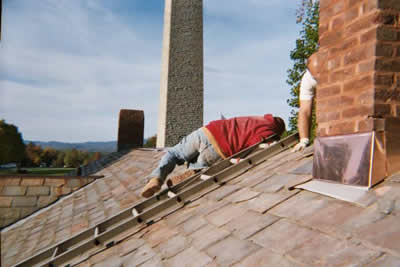
Replacing metal flashings is part of the routine maintenance of a slate roof. This historic home (ca.1790) sits in the shadow of the Bennington Monument in Vermont. Regular maintenance and upkeep, performed here by ‘Olde Mohawk’s skilled technicians will preserve the integrity and increase the longevity of the roof.

Photos: Bad repairs can be found on almost any old slate roof. Some constitute “hidden leaks,” such as #1 below, where a nail has been driven into the top of the slot, caulked, then the caulk has worn off leaving an almost invisible hole in the roof. A bib flashing would have prevented this problem and will still solve the problem if inserted at this time. #2 illustrates the same problem, this time with roof cement rather than caulk. #3 shows “face nails” that have been tarred over — these are guaranteed leaks. #4 illustrates two obvious errors: wrong type of replacement slate and exposed roof cement. #5 is another example of a multiple error — face nails, wrong type of slate and wrong shape of slate. All of the above can be removed and the roof properly repaired.
Tell Us About Your Project |

